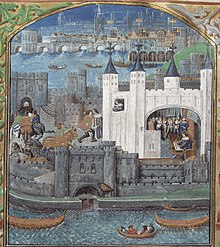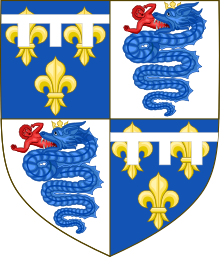Charles, Duke of Orléans
| Charles | |
|---|---|
 | |
| Duke of Orléans | |
| Predecessor | Louis I |
| Successor | Louis II |
| Born | 24 November 1394 Paris, France |
| Died | 5 January 1465 (aged 70) Amboise |
| Burial | Saint Denis Basilica, France |
| Spouse | Isabella of Valois Bonne d'Armagnac Marie of Cleves |
| Issue | Joan, Duchess of Alençon Marie, Viscountess of Narbonne Louis XII of France Anne, Abbess of Fontevraud |
| House | Valois |
| Father | Louis I, Duke of Orléans |
| Mother | Valentina Visconti |

Charles of Orléans (24 November 1394 – 5 January 1465) was Duke of Orléans from 1407, following the murder of his father, Louis I, Duke of Orléans, on the orders of John the Fearless, Duke of Burgundy.[1] He was also Duke of Valois, Count of Beaumont-sur-Oise and of Blois, Lord of Coucy, and the inheritor of Asti in Italy via his mother Valentina Visconti, daughter of Gian Galeazzo Visconti, Duke of Milan.
He is now remembered as an accomplished medieval poet owing to the more than five hundred extant poems he produced, written in both French and English, during his 25 years spent as a prisoner of war and after his return to France.
Accession[edit]
Charles was born in Paris. Acceding to the duchy at the age of thirteen after his father had been assassinated, he was expected to carry on his father's leadership against the Burgundians, a French faction which supported the Duke of Burgundy. The latter was never punished for his role in Louis' assassination, and Charles had to watch as his grief-stricken mother Valentina Visconti succumbed to illness not long afterwards. At her deathbed, Charles and the other boys of the family were made to swear the traditional oath of vengeance for their father's murder.
During the early years of his reign as duke, the orphaned Charles was heavily influenced by the guidance of his father-in-law, Bernard VII, Count of Armagnac, for which reason Charles' faction came to be known as the Armagnacs.
Imprisonment[edit]
After war with the Kingdom of England was renewed in 1415, Charles was one of the many French noblemen at the Battle of Agincourt on 25 October 1415. He was discovered unwounded but trapped under a pile of corpses.[2] He was taken prisoner by the English, and spent the next twenty-four years being moved from one castle to another in England, including the Tower of London, and Pontefract Castle – the castle where England's young King Richard II, cousin once removed of the then incumbent English King Henry V, had been imprisoned and died 15 years earlier at the age of 33.[3] The conditions of his confinement were not strict; he was allowed to live more or less in the manner to which he had become accustomed, like so many other captured nobles. However, he was not offered release in exchange for a ransom, since the English King Henry V had left instructions forbidding any release: Charles was the natural head of the Armagnac faction and in the line of succession to the French throne, and was therefore deemed too important to be returned to circulation.
After his capture, his entire library was moved by Yolande of Aragon to Saumur, to prevent it from falling into enemy hands.
Poetry[edit]
It was during these twenty-four years that Charles would write most of his poetry, including melancholy works which seem to be commenting on the captivity itself, such as En la forêt de longue attente.[4]
The majority of his output consists of two books, one in French and the other in English, in the ballade and rondeau fixed forms. Though once controversial, it is now abundantly clear that Charles wrote the English poems which he left behind when he was released in 1440.[5] Unfortunately, his acceptance in the English canon has been slow. A. E. B. Coldiron has argued that the problem relates to his "approach to the erotic, his use of puns, wordplay, and rhetorical devices, his formal complexity and experimentation, his stance or voice: all these place him well outside the fifteenth-century literary milieu in which he found himself in England."[6]
One of his poems Is she not passing fair?, translated by Louisa Stuart Costello, was set to music by Edward Elgar. Claude Debussy set three of his poems to music in his Trois Chansons de Charles d'Orléans, L.92, for unaccompanied mixed choir.
Freedom[edit]
Finally freed in 1440 by the efforts of his former enemies, Philip the Good and Isabella of Portugal, the Duke and Duchess of Burgundy, he set foot on French soil again after 25 years, by now a middle aged man at 46 and "speaking better English than French," according to the English chronicler Raphael Holinshed. Philip the Good had made it a condition that the murder of Charles' father Louis of Orleans by Philip's own father, John the Fearless, would not be avenged. (John himself had been assassinated in 1419.) Charles agreed to this condition prior to his release.[7] Meeting the Duchess of Burgundy after disembarking, the gallant Charles said: "M'Lady, I make myself your prisoner." At the celebration of his third marriage, with Marie of Cleves, he was created a Knight of the Golden Fleece. His subsequent return to Orléans was marked by a splendid celebration organised by the citizens.
He made an unsuccessful attempt to press his claims to Asti in Italy, before settling down as a celebrated patron of the arts. He died at Amboise in his 71st year.
Marriage and children[edit]
Charles married three times. His first wife Isabella of Valois (daughter of Charles VI of France and widow of Richard II of England), whom he married in Compiègne in 1406, died in childbirth.[8] Their daughter, Joan married John II of Alençon in 1424 in Blois.
Afterwards, he married Bonne of Armagnac,[8] the daughter of Bernard VII, Count of Armagnac, in 1410. Bonne died before he returned from captivity. The couple had no issue.
On his return to France in 1440, Charles married Marie of Cleves[8] in Saint-Omer (daughter of Adolph I, Duke of Cleves) and had three children:
- Marie of Orléans (19 December 1457 – 1493, Mazères). Married Jean of Foix in 1476.
- Louis XII of France (1462–1515)
- Anne of Orléans (1464–1491, Poitiers), Abbess of Fontevrault and Holy Cross Abbey Poitiers.
Honours[edit]
 Kingdom of France – Duchy of Orléans : Grand Master and Knight of the Order of the Porcupine
Kingdom of France – Duchy of Orléans : Grand Master and Knight of the Order of the Porcupine Duchy of Burgundy : Knight of the Order of the Golden Fleece ( List )
Duchy of Burgundy : Knight of the Order of the Golden Fleece ( List )
In fiction and popular culture[edit]
Charles appears as "Duke of Orléans" in William Shakespeare's Henry V. In the 2012 television adaptation The Hollow Crown, Charles is played by French actor Stanley Weber and is inaccurately portrayed as dying at Agincourt.
The critically acclaimed historical novel Het Woud der Verwachting / Le Forêt de Longue Attente (1949) by Hella Haasse (translated into English in 1989 under the title In a Dark Wood Wandering) gives a sympathetic description of the life of Charles, Duke of Orléans.
Charles is also a major character in Margaret Frazer's The Maiden's Tale, a historical mystery and fictional account of a few weeks of his life in England in the autumn of 1439, shortly before his release in 1440.
Charles is a minor character in the historical fiction novel Crown in Candlelight by Rosemary Hawley Jarman.
Charles is referenced as the author of "the first known Valentine" in Netflix original Big Mouth's Valentine's Day special, "My Furry Valentine".
Notes[edit]
- ^ Richard Vaughan, John the Fearless: The Growth of Burgundian Power, Vol. 2, (Boydell Press, 2002), 44–46.
- ^ McLeod, Enid. Charles of Orleans: Prince and Poet. Viking Press, 1971 p. 129.
- ^ McLeod p. 145.
- ^ Wikisource: En la forêt de longue attente
- ^ John Fox, "Charles d'Orléans, poète anglais?" Romania 86.3 (1965): 433–62, Mary-Jo Arn, ed., Fortunes Stabilnes: Charles of Orleans's English Book of Love: A Critical Edition (Binghamton, New York: Medieval and Renaissance Texts and Studies, 1994) and N. L. Goodrich, Charles of Orleans: A Study of Themes in his French and in his English Poetry (Geneva: Droz, 1967).
- ^ A. E. B. Coldiron, Canon, Period, and the Poetry of Charles of Orleans: Found in Translation (Ann Arbor: University of Michigan Press, 2000), p. 11.
- ^ Goldstone pp. 225–226.
- ^ a b c Norma Lorre Goodrich, Charles of Orléans: A Study of Themes in his French and in his English Poetry, (Librairie Droz., 1967), 11.
Bibliography[edit]
- McLeod, Enid, Charles of Orleans: Prince and Poet (London, Chatto & Windus, 1969)
- Arn, Mary-Jo, The Poet's Notebook: The Personal Manuscript of Charles d'Orléans (Paris, BnF MS fr. 25458) (Turnhout: Brepols, 2008).
- Charles, d'Orleans. The French chansons. (New York : Garland Pub., 1986).
- Goldstone, Nancy (2013). The Maid and the Queen: The Secret History of Joan of Arc. Phoenix Paperbacks, London.
External links[edit]
| Wikisource has original works written by or about: Charles, Duke of Orléans |
- BnF MS. fr. 25458, the personal manuscript of Charles d'Orléans at Gallica
- Works by Charles d'Orléans at Project Gutenberg
- Works by or about Charles d'Orléans at Internet Archive
- Works by Charles, Duke of Orléans at LibriVox (public domain audiobooks)

- The Online Medieval Sources Bibliography cites print and online works by Charles d'Orléans
| French nobility | ||
|---|---|---|
| Preceded by Louis I/IV | Duke of Valois 1406–1465 | Succeeded by Louis II/V |
| Duke of Orléans Count of Blois and Beaumont-sur-Oise 1407–1465 | ||
- House of Valois-Orléans
- Counts of Soissons
- Counts of Blois
- Dukes of Valois
- People of the Hundred Years' War
- Dukes of Orléans
- French poets
- Armagnac faction
- Medieval poets
- 1394 births
- 1465 deaths
- Writers from Paris
- Prisoners in the Tower of London
- Knights of the Golden Fleece
- Knights of the Order of the Porcupine
- French male poets
- French prisoners of war in the Hundred Years' War
- 15th-century peers of France

No comments:
Post a Comment